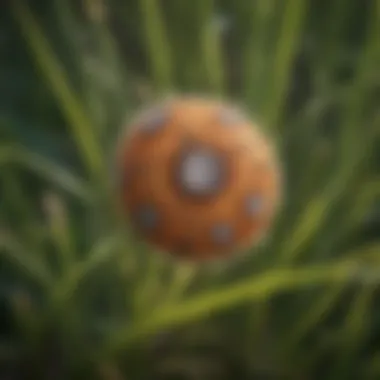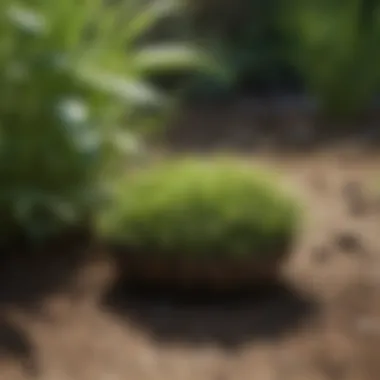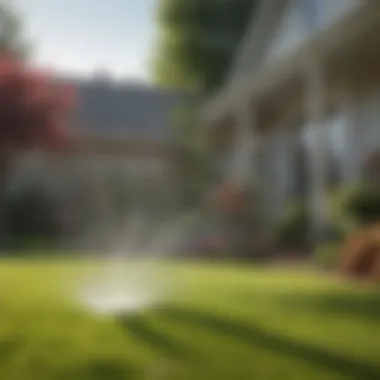Expert Strategies for Lawn Dollar Spot Treatment


Intro
Dollar spot is a prevalent fungus affecting lawns, particularly in cool, moist conditions. This disease is caused by the fungus Sclerotinia homeocarpa, which thrives under specific environmental scenarios. Understanding the biology of this fungus and its impact on turf health is crucial for effective management. This section aims to provide readers with an insight into the essential concepts and terminology surrounding dollar spot treatment, along with historical context to frame its significance.
Key Concepts and Terminology
Basic Definitions
Dollar spot refers to the distinct circular patches of grass that exhibit a lighter color, typically a tan or straw-like appearance. These patches usually range from the size of a silver dollar (hence the name) to much larger areas. The defining characteristic of dollar spot is its rapid spread, which can decimate the aesthetic quality of lawns if left untreated.
The conditions that favor the development of dollar spot include high humidity, warm temperatures, and insufficient fertilization. Notably, the fungus targets stressed grass, making healthy turf management even more crucial for prevention.
Historical Context
Historically, dollar spot was first identified in the early 20th century. Its prevalence has increased in recent decades. Factors contributing to the rise of this fungal disease include changes in climate patterns and shifts in lawn care practices. Turfgrass species, particularly those that are slow to recover from stress, are often more susceptible to dollar spot. Therefore, understanding how historical trends have shaped current management practices is vital for success in lawn care for both professional landscapers and enthusiasts.
Recent Innovations and Trends
Technological Advancements
Recently, innovations in turf management have transformed how lawn care is approached. Technological developments include the use of soil moisture sensors and smart irrigation systems. These tools help in monitoring soil health and maintaining optimal moisture levels, which are critical in preventing dollar spot. Moreover, advancements in fungicide formulations have provided more effective options for controlling dollar spot, with reduced impact on the surrounding environment.
Sustainable Practices
Sustainability in lawn care is an emerging trend. Many lawn care professionals and homeowners now emphasize the importance of using eco-friendly methods to combat dollar spot. Techniques such as integrated pest management (IPM) rely on biological controls, proper lawn maintenance, and judicious use of chemical treatments. Recognizing the interconnectedness of soil health, grass vigor, and disease prevention is becoming commonplace in modern lawn care.
Practical Applications and Techniques
Step-by-step Guides
For effective treatment of dollar spot, consider following these steps:
- Identify the Problem: Properly identify dollar spot by observing the telltale patches.
- Assess Soil Health: Conduct a soil test to determine pH levels, nutrient deficiencies, or compaction issues.
- Adjust Watering Practices: Implement a watering schedule that minimizes excess moisture but maintains sufficient hydration for grass.
- Proper Fertilization: Apply nitrogen-based fertilizers to promote healthy growth. Focus on slow-release formulations for long-term effects.
- Fungicide Application: Use fungicides specifically labeled for dollar spot, applying according to the manufacturer's instructions.
- Maintain Grass Health: Regular mowing and aeration can enhance turf resilience to future outbreaks.
Case Studies
One notable case involved a golf course in the Midwest, where extensive dollar spot damage occurred during a wet summer. The management team implemented soil testing to understand deficiencies and adjusted their fertilizer and irrigation regime accordingly. Within two growing seasons, the golf course regained health and minimized dollar spot occurrences through improved practices.
Understanding Dollar Spot
Understanding dollar spot is essential for anyone involved in lawn care, particularly for agriculture farmers and enthusiasts. This knowledge allows for better management of lawns and landscapes, ensuring overall health and aesthetics. Dollar spot, caused by the pathogen Sclerotinia homoeocarpa, stands out for its distinct symptoms and rapid spread under certain conditions. Grasping the dynamics of this fungus can lead to more effective treatment and prevention strategies.
By learning about dollar spot, one gains insight into the specific factors that contribute to its development, such as the climate, moisture levels, and nutrient availability. A deeper understanding also helps in recognizing the signs of infection early, allowing for swift action.
Biology of Dollar Spot Fungus
Dollar spot fungus requires specific conditions to thrive. The pathogen primarily operates in temperatures between 60°F to 80°F, with high humidity being a significant contributor to its growth. It affects a range of grass species, notably fine fescue, bentgrass, and perennial ryegrass.
The fungus spreads through fungal spores that are easily distributed by wind, water, and even lawn care equipment. Once these spores come into contact with susceptible grass, they take hold and can quickly cause damage. The fungus does not only harm the appearance of the lawn but can also weaken the grass, making it more susceptible to other diseases.
Symptoms of Dollar Spot


Identifying symptoms early can be the difference between a minor issue and extensive damage. Characteristic signs of dollar spot include:
- Circular patches that are typically 1 to 6 inches in diameter.
- Grass blades that appear water-soaked, gradually changing to brown or straw-like color.
- A silvery or white mycelium web on lawn surface in early morning when dew is present.
Once these symptoms are observed, timely intervention is necessary to avert extensive lawn stress and damage.
Identifying Affected Grass Species
Different grass species have varying levels of susceptibility to dollar spot. Commonly affected grasses include:
- Kentucky bluegrass: More resilient but still susceptible during hot, humid conditions.
- Fescues: Particularly fine fescue, are highly prone to this issue.
- Bentgrass: Often used in golf courses, it can become severely damaged.
By knowing which species are affected, lawn managers can tailor their treatment approaches as needed. Additionally, selecting more resistant varieties can be an effective long-term strategy to combat the fungus.
"Understanding the biology and symptoms of dollar spot paves the way for effective management and healthier lawns."
In closing, understanding dollar spot is vital in maintaining a lush, vibrant landscape. Knowledge of its biology, symptoms, and affected grass species allows for informed decisions, leading to effective treatment and prevention strategies.
Conditions Favoring Dollar Spot Development
Understanding the conditions that foster dollar spot development is crucial for effective lawn care. Dollar spot thrives under specific environmental factors and cultural practices. Recognizing and managing these conditions can significantly reduce the probability of outbreaks. Therefore, focusing on climate, soil moisture, and nutrient levels will help lawn enthusiasts effectively combat this issue.
Climate Factors
The climate plays an essential role in the development of dollar spot fungus. Warm temperatures combined with high humidity create an optimal environment for the fungus to spread. Typically, temperatures between 60 and 80 degrees Fahrenheit are conducive to growth. Extended periods of moisture, especially with morning dew, can further increase risks. This particular climate vulnerability makes it vital for lawn caretakers to monitor local weather conditions closely, as periods of prolonged humidity can signal an increased need for preventive measures. Additionally, understanding seasonal changes will help in planning and maintaining lawn health proactively.
Soil Moisture Levels
Soil moisture levels contribute significantly to the prevalence of dollar spot. Lawns with insufficient drainage or consistent saturation create favorable conditions for the fungus. It's essential to maintain appropriate moisture levels in the soil. Overwatering or allowing lawn areas to become waterlogged increases susceptibility. Conversely, extremely dry conditions also weaken grass resistance. A balanced approach in irrigation practices can help deter dollar spot. Regular checks of soil moisture can aid in applying water as needed without excessive saturation.
Nutrient Deficiencies
Nutrient deficiencies, particularly nitrogen, can heighten lawn vulnerability to dollar spot. When grass lacks adequate nutrients, it becomes stressed and more susceptible to disease. Soil tests can identify nutrient levels and reveal if your lawn is lacking essential elements. Application of the right fertilizers can bolster grass health, reducing stress and enhancing growth. In some cases, an imbalance of nutrients may result from applying overly rich fertilizers, resulting in rapid growth that also invites infestations. Thus, ensuring a balanced nutrient supply is crucial for keeping lawns robust and less prone to disease.
Prevention Strategies
Prevention is a critical aspect in managing dollar spot fungus. Engaging in effective prevention strategies can significantly reduce the chances of an outbreak. By focusing on maintaining a healthy lawn, one can create an environment less conducive to the growth of this fungus. These strategies involve proper lawn maintenance, selecting the right grass varieties, and regularly monitoring lawn conditions.
Proper Lawn Maintenance Practices
Regular Mowing
Regular mowing is one of the most essential practices for preserving the health of a lawn. When grass is kept at the proper height, it prevents overshadowing, ensuring that sunlight can reach the lower parts, which helps maintain grass health. Tall grass blades can retain moisture, creating a favorable habitat for dollar spot fungus development. By mowing regularly, homeowners can promote air circulation within the grass canopy, reducing the humidity that facilitates fungal growth. However, it is important to avoid cutting more than one-third of the grass blade at a time. This practice helps avoid stressing the lawn and keeps it lush.
Appropriate Fertilization
Appropriate fertilization plays a vital role in enhancing lawn resilience against dollar spot fungus. A balanced approach to fertilization provides vital nutrients, particularly nitrogen, which supports healthy grass growth. Without adequate nourishment, grass can become weak and more susceptible to diseases. Choosing a slow-release fertilizer can help maintain a consistent nutrient level over time. This means that the grass receives nourishment gradually, rather than in spikes, which can be beneficial during the growing season. It is crucial to test soil before applying fertilizers to understand the specific nutrient needs. Excess fertilization can lead to rapid growth, which may require more frequent mowing and can inadvertently create environments for fungi to thrive.
Proper Watering Techniques
Proper watering techniques are essential in managing the moisture levels within the lawn, which is a significant factor in preventing dollar spot. Watering deeply but infrequently allows grass roots to grow deeper. This practice makes the grass more drought-resistant and less prone to stress. It is generally recommended to water between 1 to 1.5 inches per week, ideally in the early morning when evaporation rates are lower. Adjusting the watering schedule according to weather conditions can also prevent over-saturation, which may create an ideal environment for disease development. Careful attention to runoff is crucial; allowing water to pool can have detrimental effects on soil health.


Selecting Resistant Grass Varieties
Selecting resistant grass varieties is a proactive strategy in preventing dollar spot outbreaks. Certain grass species naturally exhibit higher resistance to this fungus. Examples include fine fescue and perennial ryegrass, which have shown better tolerance compared to more susceptible varieties like Kentucky bluegrass. It is crucial to consider local climate and soil conditions when selecting grass varieties. Consulting with local agricultural centers can provide insights into the best options suited to the area. Additionally, ensuring the availability of resilient grass types not only enhances lawn aesthetics but also lessens reliance on chemical treatments, promoting a healthier lawn ecosystem.
"Investing in prevention strategies can significantly reduce the occurrence of dollar spot issues over time."
Effective prevention strategies are integral to maintaining a healthy lawn and protecting it from dollar spot fungus. By implementing proper lawn maintenance practices and selecting the right grass varieties, observers can create a robust resistance against disease.
Treatment Options
Treatment options are critical for managing dollar spot fungus in lawns. They encompass various methods ranging from chemical fungicides to organic solutions. Understanding these options allows lawn enthusiasts to tackle outbreaks effectively. Each method has its own set of benefits and considerations, guiding the user in selecting the appropriate approach for their specific situation.
Chemical Treatments
Chemical treatments are one of the primary methods recommended for controlling dollar spot. They often yield quick results and can effectively reduce fungus populations in infested areas. However, it is indispensable to understand the types of fungicides available and the best practices for their application.
Fungicides: Types and Application
Fungicides can be broadly classified into systemic and contact fungicides. Systemic fungicides are absorbed by plants and provide protection against dollar spot from within. Contact fungicides, on the other hand, remain on the plant's surface and need good coverage.
- Systemic Fungicides: These types work by being absorbed in the root or leaf. This is advantageous in that they can offer protection for an extended period. However, they might require more precise application methods.
- Contact Fungicides: These need to be reapplied often and require thorough coverage of the lawn. They are beneficial for immediate results but can sometimes lack lasting efficacy.
Understanding the unique feature of each type can help the user make informed decisions. For example, systemic fungicides may provide longer-lasting control, while contact types may be more straightforward to apply.
Timing of Applications
Timing plays a crucial role in the effectiveness of fungicides. Early intervention is critical to prevent dollar spot from spreading. The key characteristic of an application schedule is to target the fungus during its active growth phases. This usually occurs in warm, moist conditions when the grass is stressed.
"Applying fungicides at the right time increases their overall effectiveness and can minimize the impact of dollar spot on your lawn."
Regular monitoring of environmental factors will help determine the right timing. Applying too late may render the fungicide less effective, while treating too early may waste product.
Organic Treatment Methods
Organic treatment methods offer an alternative approach to manage dollar spot. These methods often focus on improving the overall health of the soil and lawn, which can help combat fungi naturally. In this section, we will review some effective organic strategies.
Use of Beneficial Microorganisms
Incorporating beneficial microorganisms can enhance the health of the lawn. These microorganisms outcompete harmful fungi like dollar spot, ultimately leading to their reduction.
- Key Characteristic: They promote a balanced soil ecosystem, which supports grass health.
- Unique Feature: They can provide a long-term solution to prevent dollar spot while improving nutrient availability to the grass.
Using these beneficial microorganisms is popular because they are environmentally friendly and can improve soil health overall. The downside is that results may take longer to observe compared to chemical treatments.
Homemade Solutions
Homemade solutions are accessible and cost-effective. They often involve common household ingredients that can deter dollar spot fungus. Solutions may include mixtures like vinegar or baking soda mixed with water.
- Key Characteristic: They are easy to apply and often safe for use around pets and children.
- Unique Feature: Many of these solutions utilize natural ingredients, thus providing a safer alternative to chemical fungicides.
Nonetheless, they may not provide the same level of effectiveness and can vary significantly in results. Home remedies are beneficial for minor issues but may struggle against severe infections.


In summary, treatment options are diverse, and each method holds its own merits and downsides. By understanding the specifics of chemical and organic treatments, one can tailor their approach to ensure a healthy lawn and effective management of dollar spot.
Long-Term Lawn Health
Understanding long-term lawn health is crucial for managing dollar spot fungus effectively. A well-maintained lawn not only looks good but also supports the ecosystem of beneficial microorganisms, which are important for plant health. Long-term health means that lawns can withstand stress, resist disease, and recover quickly from damage. This involves several components, including soil health, irrigation management, and ongoing monitoring of lawn conditions.
Soil Health Management
Testing Soil pH
Testing soil pH is foundational to maintaining a healthy lawn. Soil pH influences nutrient availability to grass and other plants. Most grasses thrive in a pH range of 6.0 to 7.0. When pH is too low or high, plants may exhibit symptoms of nutrient deficiencies, leading to weakened grass that is more susceptible to disease like dollar spot. A key characteristic of testing soil pH is that it provides valuable data that helps land managers make informed decisions about amendments. This process is a beneficial choice for those focusing on long-term lawn care. The unique feature of soil pH testing is its simplicity and affordability, making it accessible to most homeowners. However, if not done regularly, the soil chemistry can change, which is a disadvantage that may lead to overlooked issues.
Adding Organic Matter
Adding organic matter is essential for improving soil structure and fertility. Organic matter enhances microbial activity, aids in moisture retention, and promotes better root development. Its key characteristic is its ability to release nutrients gradually, supporting the lawn over time. For this article, this practice is beneficial because it helps to establish a balanced ecosystem in the soil. The unique feature of adding organic matter is that it can be achieved through various sources, such as compost or well-rotted manure. The disadvantage, however, is that it requires time and consistency to show notable improvements in soil health.
Irrigation Management
Best Practices for Lawn Watering
Best practices for lawn watering involve understanding how much and how often to water. Deep and infrequent watering encourages roots to grow deeper, making the grass more drought-resistant. This practice is also essential for reducing instances of dollar spot, as overly damp conditions can exacerbate fungal growth. The key characteristic of this approach is its efficiency in water use, which is beneficial for both the lawn and the environment. The unique feature of these practices is adaptability; they can be adjusted based on changing weather conditions. However, a disadvantage is that it requires monitoring and attention, which some may overlook.
Managing Runoff
Managing runoff is crucial for minimizing water waste and preventing nutrient leaching from the soil. Proper runoff management can help maintain soil moisture levels and reduce the amount of fertilizers needed, which can be especially helpful for preventing dollar spot. This approach emphasizes the efficient use of resources, making it a beneficial choice for sustainability-minded gardeners. The unique feature here is that it helps maintain both water quality and soil integrity. Some challenges, however, include the potential for increased labor and the need for infrastructure improvements, which can be a barrier for some lawn care enthusiasts.
Monitoring Lawn Conditions
Regular Inspection for Signs of Stress
Regular inspection for signs of stress is vital for timely intervention in lawn care. Early detection of issues like dollar spot can make a significant difference in treatment success. The key characteristic of this practice is proactive management, allowing one to notice and address problems before they escalate. This approach is a beneficial choice when managing long-term lawn health. The unique feature is its straightforwardness; it requires little equipment, just consistent observation. However, the downside is that it can become time-consuming, especially for larger lawns where more frequent checks are necessary.
Keeping a Lawn Diary
Keeping a lawn diary is an effective way to track and analyze the health of your lawn over time. Documenting events such as watering, fertilizing, and outbreaks of pests provides insights into patterns and recurring problems. This practice is beneficial because it turns subjective observations into valuable data. The unique aspect of a lawn diary is that it creates a historical record, which can be particularly advantageous for identifying long-term trends. The disadvantage may be the effort required to maintain detailed records, which could deter some individuals.
Consistency in monitoring and maintaining a healthy lawn ecosystem paves the way for preventing diseases like dollar spot.
Closure
In this guide, we explored the multifaceted approach to treating dollar spot fungus in lawns. Understanding this issue is crucial for maintaining a healthy turf. The insights provided here encompass various methods of treatment and prevention, emphasizing their relevance to both amateur gardeners and professional landscapers.
Recap of Treatment and Prevention
A successful strategy against dollar spot involves several key components:
- Chemical Treatments: Knowing the types of fungicides and their application methods helps in timely intervention. For example, products containing myclobutanil can effectively target dollar spot when used correctly.
- Organic Options: Implementing beneficial microorganisms or even homemade remedies can nurture the lawn's health while addressing the fungus.
- Preventive Measures: Proper lawn management, including mowing, fertilization, and watering practices, lays a strong foundation against future outbreaks. Selecting resistant grass varieties can serve as a robust barrier too.
Each of these approaches contributes to a holistic lawn care plan that not only treats but also prevents the onset of dollar spot.
Encouragement for Ongoing Lawn Care
Lawn care is not a one-time effort but a continuous commitment. Regular monitoring for signs of dollar spot and other lawn stress factors is vital. Maintaining soil health through testing and amending can greatly influence the lawn’s resilience.
Consider keeping a lawn diary. Documenting changes in conditions, treatments applied, and their outcomes allows for better management decisions over time.
Every small step in lawn care contributes to a broader understanding and effective management of challenges like dollar spot. The culmination of knowledge, observation, and action forms the essence of a thriving lawn that withstands the pressures of environmental and biological threats.















